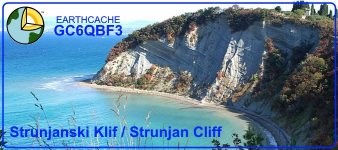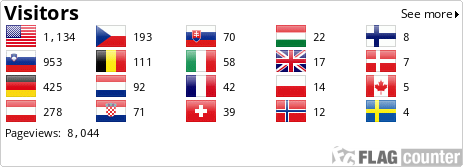[SLO]
Naravni rezervat Strunjan je del krajinskega parka Strunjan. Med najbolj značilnimi deli rezervata je previsna stena Strunjanski Klif.
Strunjanski klif je visok do 80 metrov, sestavljen iz mehkih plasti fliša, ki sta jih leta oblikovala veter in dež. Strunjanski klifi so največja znana obalna flišna stena na celotni jadranski obali. Fliš je sedimentna eocenska kamnina z izmeničnimi plastmi peščenjaka, laporovca in karbonatnega turbidita. Ker je kamnina mehka, je bil njen spodnji del podvržen nenehni morski eroziji, medtem ko so bili njeni zgornji deli spremenjeni zaradi spreminjajočih se vremenskih razmer.
Rezultati vpliva teh naravnih dejavnikov so nekateri zelo zanimivi geološki in eomorfološki pojavi, kot so skalni previsi, mikrotektonski sklepi, slikoviti prelomi in poševne zgubane plasti peščenjaka, ki se končajo v morju, medtem ko so na nekaterih krajih oblikovali naravno tlakovanje med zemljo in morjem. Ti pojavi so posebej izraziti na rtiču Strunjan in rtu Kane, kjer se debelejše plasti, nahajajo tik nad vodno gladino in tečejo skoraj vzporedno z njo. Nad njimi pa so tanjše plasti laporovca in peščenjaka zložene in stisnjene v vseh možnih vzorcih. Ob vznožju klifa, je značilna skodlasta terasa nastala med strmim pobočjem in morjem in je mestoma široka tudi do sedem metrov (Zaliv sv. Križa), medtem ko je na dveh rtih ozka in je prehodna le med oseko.
Na zgornjem robu pečine, zlasti v erozivnih koritih, je prevladujejo submediteranski listopadni gozdovi. Strme severne in zahodne stene ter zgornje robove klifa v Naravnem rezervatu Strunjan prerašča značilna gozdna združba črnega gabra in puhastega hrasta. Tam najdemo tudi brnister (Spartium junceum) in navadno kanelo (Arundo donax). Botanično najbolj zanimivo je pobočje rta Ronek, kjer se, kljub severni legi in bolj ali manj flišni podlagi, pojavljajo značilne sredozemske rastline. Najbolj zanimive med njimi so brez dvoma najbolj značilna predstavnica sredozemska makija, ti. mirta (Myrtus communis) in navadna jagodičnica (Arbutus unedo). Rt Ronek je poleg tega edini avtohtoni habitat navadne jagodičnice v Sloveniji.
Da lahko vpišete najdbo pri tem zemeljskem zakladu, morate odgovoriti na naslednja vprašanja:
[1] Katero gorovje se je pred 40 milijoni let dvigalo in gubalo v notranjosti celine?
[2] Kaj je "fliš"?
[3]Opišite razliko med vrstami flišnih kamnin, ki jih lahko odkrijete na klopci in v njeni neposredni bližini. Zakaj se posamezna vrsta kamnine uporablja?
[4] Katero majhno sivo geometrijsko figuro lahko prepoznate na manjši strani klopi, ki je najbolj oddaljena od informacijske table?
[5] Na Strunjanskem klifu je poleg laporovca in peščenjaka prisotna tudi neka druga kamnina. Katera?
[6] Slikajte klif in sliko priložite k vašemu vpisu...
Ni vam treba čakati na našo potrditev. Zaklad lahko vpišete kot najden takoj, ko ste nam poslali odgovore. Če bodo z vašimi odgovori kakšne težave, vas bomo kontaktirali.
[EN]
The Strunjan Nature Reserve is a part of the Strunjan Landscape Park. Among the most distinctive parts of the reserve is the precipitous wall of the Strunjan Cliff.
The Strunjan Cliff is up to 80 meters high and composed of soft layers of flysch, which for ages have been shaped by winds and rain. The Strunjan cliffs form the largest known coastal flysch wall on the entire Adriatic coast. Flysch is a sedimentary Eocene rock with alternating layers of sandstone, marl and carbonate turbidite. As it is soft, its bottom part has been subjected to constant erosion by the sea, while its upper parts have been decomposed a great deal by the changing weather conditions. The results of these activities are some very interesting geological and eomorphological phenomena, such as rock shelters, microtectonic joints, partly broken rock blocks and the slanting layers of sandstone terminating in the sea, while in some places creating a real natural paving between the land and the sea. These phenomena are particularly characteristic of Capes Strunjan and Kane, where thicker beds are situated just above the water surface and running almost parallel with it, with thinner layers of marl and sandstone folded and pressed above them in all possible patterns. At the foot of the cliffs, a characteristic shingle terrace has formed between the steep slope and the sea, which in places is up to seven meters wide (Bay of St. Cross), while on the two capes, it is narrow and passable only when the tide is low.
On the upper edge of the cliffs, especially in erosive gorges, the typical deciduous sub-Mediterranean community of Hop-Hornbeam and Autumn Sesleria (Seslerio autumnalis–Ostryetum) developed, in which Broom (Spartium junceum) and Reeds (Arundo donax) are also abundant. Botanically, the most interesting is the slope of Cape Ronek, where in spite of its northern position and more or less flysch substratum, the characteristic Mediterranean plants also occur. Most interesting among them are no doubt the most distinctive representatives of the Mediterranean maquis, i.e. myrtle (Mirtus communis) and Strawberry-tree (Arbutus unedo). Cape Ronek is, furthermore, the only autochthonous habitat of Strawberry-tree in Slovenia.

[1] Limestone rock shelter
[2] Gravelly shore with boulders
[3] Layers of Marl and Sandstone
[4] Erosion gullies, from which material is washed out
[5] Sub-Mediterrenean deciduous forest
In order to log this earthcache, you have to answer the following questions:
[1] Which mountains lifted and folded some 40 million years ago?
[2] What is "Flysch"?
[3] Describe the difference between the types of flysch rock that can be discovered directly and from up close on the bench and explain what they are used for.
[4] What gray geometric figure do you recognize at the (small) side of the bench (side furthest away from the information board) ?
[5] What other type of rock is also featured at the Strunjan Cliff?
[6] Take a picture of the cliff and attach it to your log ...
You do not have to wait for our confirmation. Feel free to log the find as soon as you sent us your answers.
If there are problems with your answers, we will contact you.
[D]
Das Naturschutzgebiet Strunjan ist ein Teil des Landschaftsparks Strunjan. Unter den charakteristischsten Teile der Reserve ist die schroffen Wand des Strunjan Klippe.
Die Strunjan Klippe ist bis zu 80 Meter hoch und besteht aus weichen Schichten des Flysch, die Zeiten haben durch Wind und regen geprägt. Die Strunjan Klippen bilden die größte bekannte Küsten Flyschwand an der gesamten Adria. Flysch ist ein Sediment Eozän Gestein mit Schichten aus Sandstein, Mergel und Carbonat Trübe abwechseln. Da es weich ist, seinen unteren Teil durch das Meer konstante Erosion ausgesetzt, während die oberen Teile sehr viel durch die wechselnden Wetterbedingungen zerlegt wurden. Die Ergebnisse dieser Aktivitäten sind einige sehr interessante geologische und eomorphological Phänomene wie Abris, microtectonic Gelenke, teilweise gebrochene Felsblöcke und die schrägen Schichten aus Sandstein endet im Meer, während an einigen Stellen eine echte natürliche Pflasterung zwischen dem Land zu schaffen und das Meer. Diese Phänomene sind besonders charakteristisch für Capes Strunjan und Kane, wo dickere Betten liegen knapp über der Wasseroberfläche und läuft damit fast parallel mit dünneren Schichten von Mergel und Sandstein gefaltet und über sie in allen möglichen Mustern gedrückt. Am Fuße der Klippen, eine charakteristische Schindel Terrasse hat zwischen den steilen Hang und dem Meer gebildet, die stellenweise bis zu sieben Meter breit (Bucht von St. Cross), während auf den beiden Kaps, es schmal und befahrbar ist nur wenn die Flut ist gering.
Am oberen Rand der Klippen, vor allem in erosive Schluchten, die typische Laub submediterranen Gemeinschaft Hopfenbuche und Herbst Sesleria (Seslerio autumnalis-Ostryetum) entwickelt, in dem Besen (Spartium junceum) und Reeds (Arundo donax) sind auch reichlich. Botanisch gesehen ist die interessanteste die Steigung von Cape Ronek, wo trotz der nördlichen Lage und mehr oder weniger Flysch Substrat, auch die charakteristischen mediterranen Pflanzen auftreten. Die schönsten unter ihnen sind wohl die markantesten Vertreter der mediterranen Macchia, das heißt Myrte (mirtus communis) und Erdbeerbaum (Arbutus unedo). Cape Ronek ist darüber hinaus die einzige autochthone Lebensraum der Erdbeerbaum in Slowenien.

[1] Kalkstein Roch Obdach
[2] Shore mit Geröll
[3] Schichten aus Marl und Sandstein
[4] Erosionsrillen, aus dem Material ausgewaschen
[5] Submediterranes Laubwald
Um diesen Cache zu loggen, müssen Sie die folgenden Fragen beantworten:
[1] Welche Berge gehoben und gefaltet vor etwa 40.000.000 Jahre?
[2] Was ist "Flysch"?
[3] Beschreiben Sie den Unterschied zwischen den verschiedenen Arten von Flysch Felsen, der direkt entdeckt werden können und aus nächster Nähe auf der Bank und erklären Sie was sie für verwendet werden.
[4] Was grauen geometrischen Figuren, erkennen Sie an der (kleine) Seite der Bank (Seite am weitesten entfernt von der Informationstafel)?
[5] Was andere Art von Gestein wird auch am Strunjan Cliff gekennzeichnet?
[6] Bitte nehmen Sie ein Bild von der Klippe und fügen Sie es zu Ihrem Log ...
Sie müssen nicht auf unsere Bestätigung warten. Fühlen Sie sich frei den Fund anmelden, sobald Sie uns Ihre Antworten gesendet hat.
Wenn es Probleme mit Ihren Antworten sind, werden wir Sie kontaktieren.
Več Informacij / More Info / Weitere Infos
BANNER

Copy / Paste the following code into your profile:
<a href="http://coord.info/GC6QBF3" target="_blank"><img src="https://s3.amazonaws.com/gs-geo-images/f80f79bf-bcc7-4df5-afa9-93c81091167d_l.jpg" alt="Strunjanski Klif / Strunjan Cliff" title="Strunjanski Klif / Strunjan Cliff" /></a>
